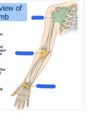Pectoral Region and the Brachial Plexus Flashcards
(71 cards)
The upper limb has several important transition areas that provide passage and protection to structures
The axilla is an irregularly shaped pyramidal area for passage of major neurovascular structures from the neck to the arm
Cubital fossa (anticubital) is a triangular depression anterior to the elbow for passage of the brachial artery and median nerve
Carpal tunnel represents a gateway to the palm for the 9 long flexors tendons and the median nerve
Acromial end of the clavicle articulates with the acromion of the scapula at the ______
acromioclavicular joint (AC)
Sternal end articulates with the manubrium of the sternum at the
sternoclavicular joint (SC)
Clavicle Fractures
Most frequently fractured bone in body
80% of adult fractures are through the middle 1/3rd of bone
Clinically obvious fractures-patients hold and support arm
SCM elevates proximal fragment
Shoulder on affected side is usually lower than other side
Can fracture in babies during labor/delivery as shoulders traverse the birth canal
synovial joint between the clavicle and the manubrium of the sternum
Sternoclavicular Joint (SC)
SC joint capsule is reinforced by strong _______ ligaments (essentially thickened portions of the joint capsule) along with the _____________ which courses along the superior aspect of both joints and the manubrium
anterior and posterior sternoclavicular; interclavicular ligament
________ anchors sternal end of the clavicle to the 1st rib
Costoclavicular ligament
nNumerous ligaments help strengthen the AC joint:
- Acromioclavicular ligament-provides superior strength to the joint capsule
- Coracoclavicular “extrinsic” ligaments- strong pair of ligaments that unites coracoid process and the clavicle (trapezoid & conoid ligaments)
- Coracoacromial ligament (arch)- courses between the coracoid and acromion processes
nSynovial joint between the acromion and clavicle
n
nSurrounded by a loose fibrous capsule
Acromioclavicular Joint (AC)
3rd degree AC injuries (sometimes refered to as _____ because
“shoulder separations”) - the shoulder separates or falls away from the clavicle due to the weight of the arm
4 thoracoappendicular muscles
pectoralis major
pectoralis minor
subclavius
serratus anterior
pectoralis major inserts into the
Inserts into the lateral lip of the intertubercular sulcus (bicipital groove) of the humerus
pectoralis major is innervated by
nInnervated by the medial & lateral pectoral nerves
pectoralis minor Inserts into the _____of the scapula
coracoid process
the pectoralis minor is innervated by
Innervated primarily by the medial pectoral nerve
The pectoralis minor forms a “bridge” over the major neurovascular structures entering the arm:
- Axillary artery
- Axillary vein
- Brachial plexus
§ Continuation of the
subclavian artery as it
passes the lateral
margin of the 1st rib
§ Provides vascular supply
to the pectoral girdle
and shoulder region
Divided into three parts
by the pectoralis minor muscle
§ Continues into the arm as the
brachial artery as it passes
lateral to the teres major muscle
Axillary Artery
n3rd part of axillary artery has three branches
- Subscapular
- Anterior humeral circumflex
- Posterior humeral circumflex
Subscapular- largest branch supplies
muscles and anastomoses around the scapula, gives rise to the thoracodorsal artery and the scapular circumflex (triangular space)
Anterior & Posterior Humeral circumflex- help vascularize the
humerus and surrounding muscles, (posterior courses through the quadrangular space)
Many of these branches of the axillary artery contribute
to a large “anastomotic arcade”
that provides collateral circulation
around the _____
scapula/muscles
“Real Tarheels Drink Cold Beer”


The roots are Formed by the ventral rami of
_______ spinal nerves
C5 through T1;
These ventral rami of
C5-T1 form the “roots”
or the “origins” of the
brachial plexus
The roots of the brachial plexus
then unite to form 3 trunks:
C5 & C6 unite to form the
superior trunk
C7 forms the middle trunk
C8 & T1 unite to form the
inferior trunk




















































